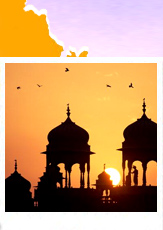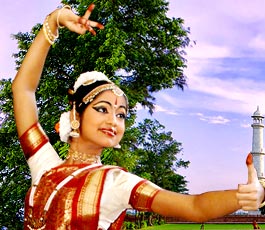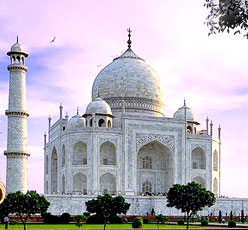 It is believed that constant invasions from the North
hunted the native Indians or Dravidians to the South and there are
distinct racial, linguistic and cultural differences between South India
and North India. South Indians venerate the beauty of the body and
motherhood as the embodiment of the eternal universe. Its dramatic
dances, clothing and exquisite sculptures, all reflect this policy. The
feminine grace is used skillfully and enhanced in the elaborate dance
forms of South India such as Mohiniaattam, which means the dance of the
enchantress and Bharathanatyam that expresses the celebration of beauty
and the universe. The latter follows rigid tenets of perfectly erect
posture, a well-rounded and proportionate body mass, very long hairs and
a curvaceous waist.
It is believed that constant invasions from the North
hunted the native Indians or Dravidians to the South and there are
distinct racial, linguistic and cultural differences between South India
and North India. South Indians venerate the beauty of the body and
motherhood as the embodiment of the eternal universe. Its dramatic
dances, clothing and exquisite sculptures, all reflect this policy. The
feminine grace is used skillfully and enhanced in the elaborate dance
forms of South India such as Mohiniaattam, which means the dance of the
enchantress and Bharathanatyam that expresses the celebration of beauty
and the universe. The latter follows rigid tenets of perfectly erect
posture, a well-rounded and proportionate body mass, very long hairs and
a curvaceous waist.The popular South Indian philosophy comes from 'Natyashastra', the treatise on Dance composed by the sage Bharatha, which states that the body is your world. The saree is an unstitched draping cloth that not only enhances the curvaceous shape of the women but also only partially covers the midriff exposing the stomach and the navel. The philosophy behind it was that the navel of the Supreme Being is the source of life and creativity. The male version of saree was lungi or mundu that followed the same principles. Traditionally, South Indian sculptors would start their work from the navel of the divinities that were kept unclothed by the saree that was placed right at the centre of the sculpture. The rich and structured South Indian music is known as Carnatic music and has sensuous rhythms. The most famous composers of South Indian music are Thyagaraja, Purandara Dasa, Vasudevachar and Swathi Thirunal.
The rich and artistic South Indian literature and philosophy has always been close to the Nature along with its blessings and rhythms. Some of the most famous South Indian epics are Silappadhikaram or Cilappatikaram by Ilango Adigal and Tholkappiam written by Tholkappiar and Thirukural composed by Thiruvalluvar. In most of the South Indian literary works, women are considered very powerful, especially the feminine powers of a married woman are considered to be very auspicious, protecting and empowering her husband and children. Tamil, Kannada, Telugu and Malayalam literature is very rich and has its own place. Other inseparable parts of South Indian culture that are worth mentioning are the inspirational temple sculptures of Hampi, Badami and Mahabalipuram and the mural paintings of Travancore and Lepakshi temples. The paintings of Raja Ravi Varma based on South Indian life and mythologies are considered classics while the Dravidian mural paintings in the Mattancherry palace and the Shiva kshetram in Ettamanoor are some of the most popular tourist attractions of the region.








